
Day 3: Exploring the capital
Yerevan
My solo days start from then. The most advantageous thing of travelling alone is that you are your own boss. You follow your desires without having to listen to anybody. You plan the best for yourself, choose the most suitable route for you and just get going.
Therefore, I decided to start my journey with a historical figure within a museum. Established on the north side of the city on a hill, Mayr Hayastan (Mother Armenia) statue contains the Mother Armenia Museum of the Ministry of Defense under her skirt. The statue in the Haghtanank Park (Victory Park) is located on the East side of the park right opposite to the Eternal Fire. Mother holding a sword with both hands, having a height of 22 meters, symbolizes peace through strength. Meanwhile, the statue honors the female figures that were armed to help their husbands fighting back the Turkish troops and Kurdish irregulars. Mother Armenia, situated on a hill overlooking the capital, shaped of hammered copper, makes itself look like as the guardian of the city.

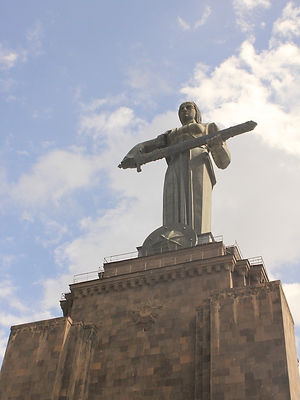
Once you enter the museum inside the pedestal, you feel like you are in a battlefield surrounded with enemies. Armenia has passed through serious though phases. Its history is full of wars, bitter moments, pillages, clashes, conflicts, under the auspices of other nations and governments. Most of those sad memories were displayed in chronological order in the museum. The exhibition flashed civic and military heroes who bravely served for Armenia. Famous Armenian faces were also exhibited as a great honor to the Armenian race.


National Flag of the Republic of Armenia:
The law 'On the State Flag of the Republic of Armenia" was adopted on August 24, 1990, by the Supreme Soviet of the Republic of Armenia. The tricolor flag consists of horizontal lines of red, navy and orange evenly distributed from top to bottom.
There are several assumptions about the symbolization of the colors. While some explanations represent the official definition, other sources claim unofficial definitions.
To combine official and unofficial definitions;
-The color red symbolizes the blood shed by Armenians in the defiance of their country, Armenian Highlands, Armenians’ incessant struggle for survival, Christian faith, independence and freedom.
-Navy (blue) symbolizes the pure Armenia sky and the aspiration of the Armenian nation to live under the peaceful sky.
–Orange (also described as color of apricot) signifies national courage and industriousness and symbolizes the talent for creative work and diligence of the Armenian people.
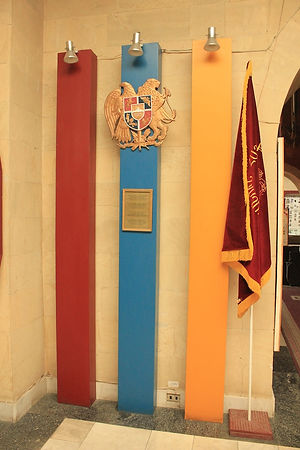
Five vital elements of the emblem are described as:
The sword represents the power and strength of the nation, breaking the chains of oppression.
The broken chain represents effort shown by the nation to gain freedom and independence.
The wheatears represent the hard working nature of the Armenian people.
The feather represents the intellectual and cultural heritage of the Armenian people.
The ribbon represents the colors of the flag of Armenia.
National Emblem and Coats of Arm of the Republic of Armenia:
The law “On the State Coat of Arms of the Republic of Armenia” was adopted on April 19, 1992, by the Supreme Soviet of the Republic of Armenia.
On a shield, positioned in the center, Mount Ararat is represented with Noah's Ark and the coats of arms of the four royal dynasties of the historical Armenia: from top to left - that of the Bargratunides, from top to right - that of the Arshakounides, from bottom to left - that of Artashesides, from bottom to right - that of the Rubenides. The shield is upheld by an eagle (on the left) and a lion (on the right). There is a sword, as well as a branch of a tree, a bundle of spikes, a chain and a ribbon pictured below the shield. Golden is the main color of the Coat of Arms of the Republic of Armenia. The colors of the kingdoms of the historical Armenia are as follows: from top to left - red, from top to right - blue, from bottom to left - blue, from bottom to right - red, with orange-painted Mount Ararat positioned in the center on a shield. The foregoing colors emblematize the colors of the national flag of the Republic of Armenia.
The Anthem:
"Mer Hayrenik" / "Our Fatherland"
The Supreme Soviet of the Republic of Armenia adopted the Anthem of the Republic of Armenia on July 1, 1991.
It is based on the Anthem of the First Armenian Republic (1918-1920), but with different lyrics. The author of the lyrics is poet Mikael Nalbandian (1829-1866).
As seen in the picture on the right side, an interpretation of the Vartanank War (also known as “The battle of Avarayr”)
The war can be assumed as a turning point in the religious and political history of Armenia.
The battle between Armenian Army AND Sassanid Persia was fought on 26th of May 451 AD.
Although the Persians were victorious on the battlefield itself, the battle proved to be a major strategic victory for Armenians, as Avarayr paved the way to the Nvarsak Treaty (484 AD), which affirmed Armenia's right to practice Christianity freely.
Peace was therefore concluded on the basis of three principles that the Armenians proclaimed they would not renounce, even at the risk of annihilation:
*No one was to be forced to change religion.
*People were not to be judged on the basis of their social condition, but rather according to their actions
*No action based merely on hearsay was to be taken by the authorities against anyone; rather, they could act only with full knowledge of the case in point.

These same objectives could well be pursued today in many places and circumstances.
After the peace treaty drawn up at Nvarsak, Valash bestowed upon the commander-in-chief of the Armenian forces, Vahan Mamikonian, the title of marzpan, that is, plenipotentiary governor, and he effectively governed Armenia with full powers. This situation of relative tranquility and prosperity lasted for forty years or so, after which Armenia became yet again the theatre of encounter between Byzantium and Persia and was to remain thus for nearly all the sixth century.
Who were those people
on the right hand?
Those in the figures, awarded for the highest title in the Republic of Armenia.
All the characters displayed at the pictures were “National Heroes of Armenia”.
The list consisted of 15 recipients.

Tatul Krpeyan: Armenian fedayi(freedom fighter), military leader and commander
-
Born in the village of Areg, Soviet Armenia, 1965.
-
Completed Technical School of Talin. 1984.
-
Served in the Soviet Army, 1984-1985.
-
Studied at Yerevan State University / Faculty of History, 1987-1990.
-
Member of the “Unification’’ organization since 1987.
-
History teacher in Getashen school since 1990.
-
Joined the “Armenian Revolutionary Federtio’’ to fight in Nagorno-Karabakh War, 1990.
-
Headed the self-defense of the sub-district Getashen-Martunashen, 1990-1991.
-
Taken hostage and killed in “Operation Ring’’ by the Soviet-Azerbaijani special police, 1991.
-
Posthumously awarded the highest title of the National Hero of Armenia and received the highest order of Hayrenik, 1996.

Karen Demirchyan: Armenian political and statesman
-
Born in Yerevan, Soviet Armenia, 1932.
-
Graduate of Faculty of Mechanics at Yerevan Polytechnical Institute, 1954.
-
Member of the communist party since 1954.
-
Third secretary of the Yerevan party committee, 1966.
-
Secretary of the Armenian Central Committee, 1972.
-
First secretary of the Armenian Communist Party, 1974.
-
Chairman of the Armenian Supreme Soviet, 1976.
-
Director of the Hayelectromekena electrical equipment plant, 1991.
-
Received the highest order of Hayrenik, 1996.
-
Lost the presidential elections against Robert Kocharyan, 1998.
-
Formed the People’s Party with Vazgen Sargsyan to form the Miasnutyun(Unity), 1999.
-
Elected as the Parliament Speaker, 1999.
-
Assassinated in the Armenian Parliament, 1999.
-
Posthumously awarded the highest title of the National Hero of Armenia.

Vazgen Sargsyan: Armenian military commander and politician
-
Born in Ararat village, Soviet Armenia, 1959.
-
Studied at Yerevan Institute of Physical Culture, 1976-1979.
-
Taught physical education in a secondary school, 1979-1983.
-
Communist Youth League leader at the cement factory in Ararat, 1983-1986.
-
Head of the publicity department of the Garun(Spring) literary monthly in Yerevan, 1986-1989.
-
Commander of irregular troops at Nagorno-Karabakh War, 1990-1992.
-
Defense Minister of Armenia, 1992-1993.
-
State Minister on Defence, National Security and Internal Affairs, 1993-1995.
-
Defense Minister of Armenia, 1995-1999.
-
Leader of the Republican Part, 1998-1999.
-
Prime Minister of Armenia, 1999.
-
Assassinated in the Armenian Parliament, 1999.
-
Posthumously awarded the highest title of the National Hero of Armenia and Hero of Atshak, 1999.
-
Also received the highest order of Hayrenik and highest order of Gold Eagle.

*The assassination of the significant political members of the parliament is among the most controversial catastrophes in post-Soviet Armenian history.
Kirk Kerkorian: American businessman and philanthropist
-
Born in California, USA, 1917.
-
Involved in hotel construction, cinema and automobile industry.
-
President of the Tracinda Corporation
-
Famous with his donations with measurement of millions of dollars for the general recovery of 1988 Spitak Earthquake
-
Also focused on constructing the Goris-Stepanakert highway, reconstructing the damaged zones of the earthquake and building new cultural institutions
-
Was awarded the highest title of National Hero of Armenia and received the highest order of Hayrenik, 2004
-
Died in California, USA, leaving a worth 4 billion dollars of fortune, 2015
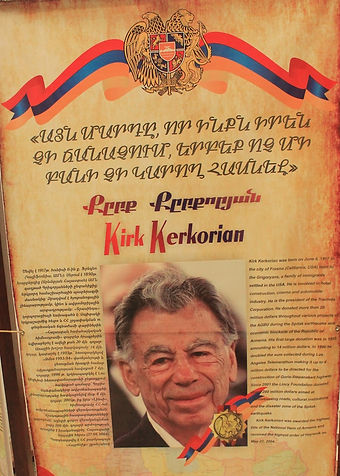
Charles Aznavour: French singer, songwriter, actor and public activist
-
Born in Paris, France, 1924.
-
Author of more than a thousand songs
-
Actor, starring in 60 movies selling well over 100 million records
-
Dedicated numerous songs to Armenia, among them “Kez hamar Hayastan“, “Nrank Inkan“ and “Inknakensagrutyun“
-
Founded “Aznavour to Armenia“ charity foundation after the devastating Spitak earthquake.
-
Was awarded the highest title of National Hero of Armenia and received the highest order of Hayrenik, 2004.
-
Also was awarded “Grigor Lsavorich“ medal of the Republican of Nagorno-Karabakh.
-
RA(Royal) Ambassador to Switzerland and permanent representative of the RA to the UN office in Geneva since 2009.
See biographical timeline of his successful life: (He is a true legend who passed away recently)

If interested here is the full list of the National Heroes …
Exiting from the main entrance door, I digested all the military acts, rebels, resistance, wars, frictions and conflicts all of which can be treated as turning points for the Republic of Armenia. To get more information about Soviet Armenia, (the period from 1920s) before the announcement of independency on 21st of September 1991, I jumped into my car off to the History Museum of Armenia.
Located at the North-East side of the Republic Square, Yerevan’s main square, the History Museum sheds light on the Armenian history from 1500 BC up until today.
The full list of the expositions contains the following topics:
Newly Discovered Objects, Ani Armenia in the 9th-13th cc, Dvin. Armenia in the 9th-13th cc, Armenian Applied Arts, Mystery of the Burial Rite, Armenian Carpets, Treasures of the Armenian Church, The Charm and Beauty of Metal, Armenian Ceramics, Armenian Sculptural Reliefs, Armenian Genocide – 90, Armenia in Historic Maps, Armenia Sacra, From Paleolith to the Bronze Age, Dvin. 11th - 8th cc BC, Bridging Generations, The Embroidery of Van, Leather Shoe, The Door of the Arakelots, Urartu – The Kingdom OfVan, Nerkin Naver, The European Night Of Museums, Soviet Armenia, Independent Republic Of Armenia, Stamps of the Republic of Armenia Memorial coins issued by the Central Bank, Dvin. A Capital Between Europe And Asia, Ani. History and Culture, The Eternity Of Writing, Writing As Witness Of The Times, Armenia 4th BC.-3rd AD., 170 Newly-Acquired Objects, Armenian National Costume 18th-19th cc., New Jugha: The Cradle of Armenian Printing, "Museum Night" 2012, "Museum Night" 2013, Lost Relics: Cultural Genocide 1915, Armenia in the 4th- 9th centuries: History and Culture, A Time to Gather Stones, Banished Families, The Culture of Shengavit, Armenian Genocide – 100.
“Urartu – The Kingdom of Van’’, “Soviet Armenia’’ and “Armenia in Historic Maps’’ were at the top of my list.
Urartu Kingdom existed between 9th – 6th centuries BC. I remember asking the museum attendant for some further details about the objects found in the excavations. Especially the huge ceramics impressed me.
As I have been living in Russia for the past nine years, Soviet Armenia exposition expectedly caught my attention. There the documents, photographs and the objects displayed, exposed the difficulties of a ghost nation living under the strict Russian regime.
I was especially interested in the exposition “Armenia in Historic Maps” as it illustrated the emigration and immigration paths of the nations resulting from significant historical incidents.
Apart from these exhibitions, administrative regions of Armenia and their defining characteristics were also presented at the passageway in front of the museum.
In addition to the country’s capital Yerevan, Armenia consists of 10 provinces which are Aragatsotn, Ararat, Armavir, Gegharkunik, Kotayk, Lori, Shirak, Syunik, Tavush, Vayots Dzor.
Gegharkunik Region (Province) was exhibited briefly...


Panoramic view of “History Museum of Armenia” with its lovely fountain in front
The buildings around the Republic Square were also very appealing from the outside.
The Ministry of Foreign Affairs was one of them located on the Northern-West side of the square.

THE MINISTRY OF FOREIGN AFFAIRS
I sat down on a bench having the full view of the square to enjoy my take-away coffee. After this ten-minute-rest, I walked to The National Gallery of Armenia, which was also located in the same building with the History Museum.
The Gallery was founded in 1921 by the decree of the Armenian Soviet Socialist Republic. It was renamed as the first State Picture Gallery of Armenia in 1947 and then the National Gallery of Armenia in 1991.
Pharaon Mirzoyan, a popular Armenian painter, is the current director of the gallery. In chronological order, here are the awards he was granted:
1986 Awarded the medal “For Labour Virtue”
2005 Awarded the “Gold Medal” of the Ministry of Culture of RA
2005 Awarded the medal “Aksel Bakunts” (Syunik Region)
2006 Honored Art Worker of the Republic of Armenia
2006 Full member of the Petrov Academy of Fine Arts and Sciences (Saint Petersburg)
2007 Awarded the State Reword of the Republic of Armenia
2008 Awarded the order of “Chevalier des Arts et des Lettres”
2009 Awarded the gold medal “Fridtjof Nansen”
2014 People’s Artist of the Republic of Armenia
The museum contained classical works from across the world. Egyptian, Greek, Italian, Flemish, Spanish, German, Swiss, Belgian, Austrian, Dutch, French, Russian (extensively presented) and surely Armenian paintings, engravings, graphic works were displayed on the wide, long and smooth walls of the spacious museum rooms.
Armenian art was broader in amount with comparison to the others. The gallery’s collection of historical Armenian art is the largest in the world. Wide collections of paintings, sculptures and graphics were exhibited with respect to their era. The paintings especially illustrated the evolution of the Armenian painting from the 6th century AD to the 20th century. Artistic development of individual painters was easily distinguished across eras.
The sculptures were mostly prehistoric worship monuments that passed through several historical stages.
The graphics were also breathtaking. More than 4000 drawings, pastels, book illustrations, caricatures, and posters of about 250 Armenian painters formed the core of the graphic collection of the Museum.
From my point of view, the most memorable items of the gallery were the great medieval wall paintings. Although it was strictly forbidden to take pictures, I almost begged for one piece of shot and got what I wanted…
Panoramic view of “History Museum of Armenia” with its lovely fountain in front
Panoramic view of “History Museum of Armenia” with its lovely fountain in front
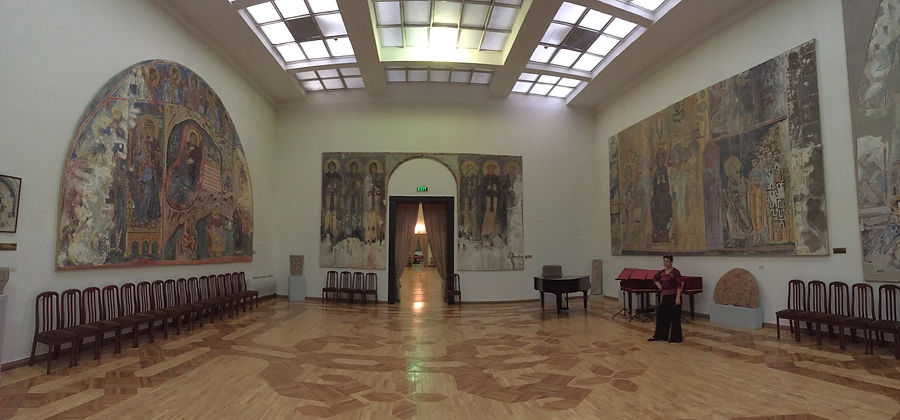
NATIONAL GALLERY-WALL PAINTINGS
After touring three grand museums of the capital, I decided to see something outdoor. Vernissage marketplace was the right address for that. I parked my car on the Buzand Street parallel to the market and right opposite to the market, I realized the arty Tufenkian Historic Yerevan Hotel (one of the Tufenkian Heritage chain hotels) standing there with it’s charming silhouette.

TUFENKIAN HISTORIC YEREVAN HOTEL
Commencing my tour at Vernissage, I started walking through the alley of hand-made art. Objects, souvenirs, accessories, even musical instruments were all tailored by gifted hands.

VERNISSAGE
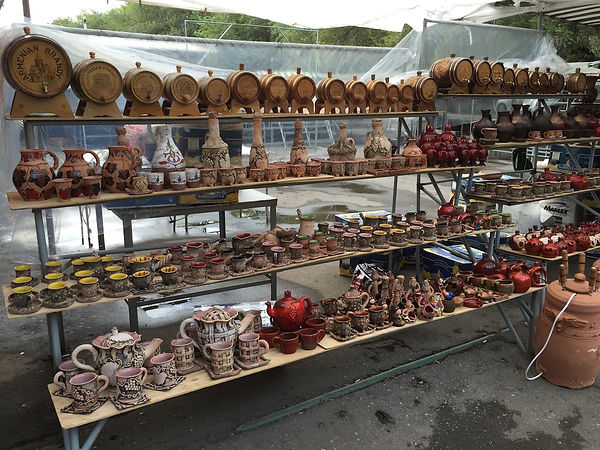
VERNISSAGE

VERNISSAGE

VERNISSAGE

VERNISSAGE
The most impressive stand of the marketplace was the works of a great author Hrachya Ohanyan.

Ohanyan’s whole creation showed great artistic examples of woodwork.
You may have a look at his uncountable range of uncountable works, including chessboards, backgammon boards and wall clocks, from his Facebook fan page.
While some of the salesmen were struggling to catch customers’ attention, the others were bored of exhibiting their works and were playing chess.
The game was about to end without a clear winner yet.

To make my tour unforgettable, I bought a small rosary coated with varnish for my father and left the market. (I still remember my haggle with the shopkeeper. He got tired of my efforts to cut down the price, so reluctantly accepted my last offer as he was closing down his stand very soon.)

After the marketplace visit, I started walking towards my next target, St. Gregory the Illuminator Cathedral. The majestic cathedral was within a ten-minute walking distance from Vernissage. Seeking for the main gate, as I failed to find the proper way, I entered from a side door. Extremely amazed by the interior of the cathedral, I started taking wide angled pictures from different corners.
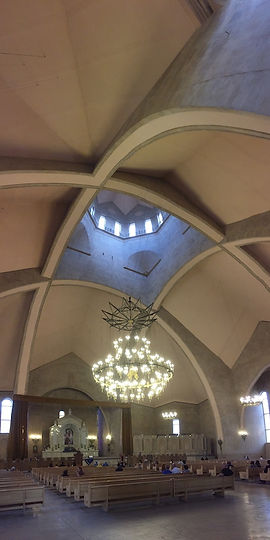
ST. GREGORY the ILLUMINATOR CATHEDRAL

Following the daily ritual sermon by a group of priests, I remained seated on one of the prayer benches for a couple of minutes and then decided to leave in the middle of the service. As I was approaching to the main entrance, I have noticed a man on his knees bending his knees underneath a bower paying his respects right in the center of the entrance hall.

This time, unlike my unusual entrance to the cathedral, I crossed myself and exited. As soon as I raised my head up underneath the main entrance gate, I noticed the beauty of the geometry. I reached out for my camera to capture the moment forever.

Descending from the outside stairs of the cathedral, I grabbed my camera once again to capture the front view of the structure.

St. Gregory the Illuminator Cathedral (also known as the Cathedral of Yerevan), situated in the Kentron district of Yerevan, is currently the largest cathedral of the Apostolic Armenian Church in the world. The cathedral is a great example of Armenian architecture. Head architect of the project, Stepan Kurchyan, concluded his design with a capacity of 1700 seats in 1997. The construction commenced the same year and finished in 2001. Sanctification of the cathedral took place in September 2001 on the occasion of the 1700th anniversary of the proclamation of Christianity as the state religion of Armenia.
It was late evening when I finished my visit to the greatest Armenian cathedral of the world.
I forgot to mention that, I had a heavy lunch at Ayntab Restaurant, the one I had explored the previous day. Therefore, I was not feeling hungry at all. Reaching my hostel for a quick shower, I checked out on my phone for places near me to hang out. I found two hit places to experience the Yerevan nightlife. The first place was a jazz club called ”Malkhas Jazz Club” on Pushkin street with live music. Upon reaching the club, I was guided to the bar as all the tables had already been reserved. It was a club over two stories with the stage on the first floor. I was seated on the second floor with a bit of view of the state. The interior was simple but suitable for a nice looking jazz bar. Enjoying live jazz music, I ordered a fruit-based dessert and a glass of red wine. The wine was Armenian with a bit of dry and bitter taste. On the other hand, I can still remember the delicious taste of the baked pear with sweet sauce, garnished with a scoop of ice cream.
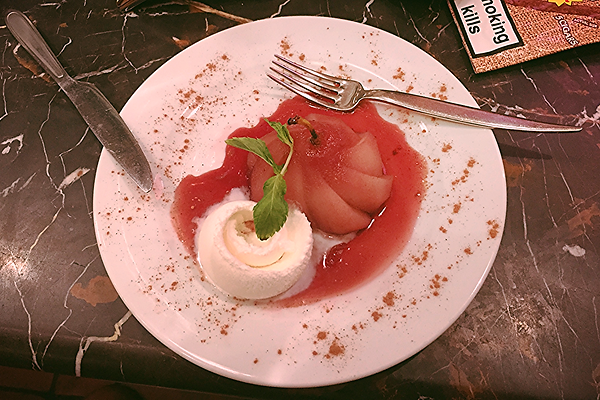
After staying there for an hour, I left the jazzy atmosphere with great satisfaction. From one bar to another, the second stop was ”Calumet” on the same street.
My first impression about this pub looking lounge bar was ok. It was more like an authentic place where I thought they would play local music. Although the bar was packed, the rhythms of the songs were quite cool. I asked for a local beer, so the bartender advised me to try the bottled Kilikia lager beer. I really loved the taste. It reminded me of the taste of my favorite Turkish beer Efes Pilsener.
Whilst sipping my beer, I got tuned to the warm atmosphere. Then I ordered some salty peanuts to company the beer. All of a sudden, I decided to light a cigar (actually I’m almost a non-smoker). Seeking for a lighter, I met the guys sitting right next to me. First, I started a conversation with the guy who was allergic to peanuts (which I had ordered to company my beer). Based on a true childhood story, he, Sevada, went on explaining the reason for his allergy and how when he had first tasted peanuts, he was almost dying. Although he decided to give peanuts another try, it still ended up with the same awful outcome. Since then, he promised himself not to touch peanuts ever again. After listening to his story, I decided against offering Sevada my peanuts.
Moving on from this, I met the other members of the group. There were two girls with him. We started chatting on everyday issues, about my trip, what they were doing for a living etc. As they were preparing to take their leave, Sevada asked me if I would like to join them to have a drink in another pub. We, four of us, left Calumet heading to other venue. On the way, I learnt that Sevada was a senior architect, running an architectural bureau in the town. We talked about the city plan and the landscaping design of the town. He was so sorry to see the changing structure of the historical buildings. From his point of view, the renovation works beyond the city center were destroying the cultural value of the old Yerevan town, which for him was unacceptable. Actually, it was not an appropriate time to talk about those serious issues. Then, we entered an underground pub. The place, which I do not remember the name, was right in the city center. So, this may explain the weekday-crowd inside. After having one more drink, we split up to get back to our places for some sleep and to mark the end of the long 3rd day in Armenia…
